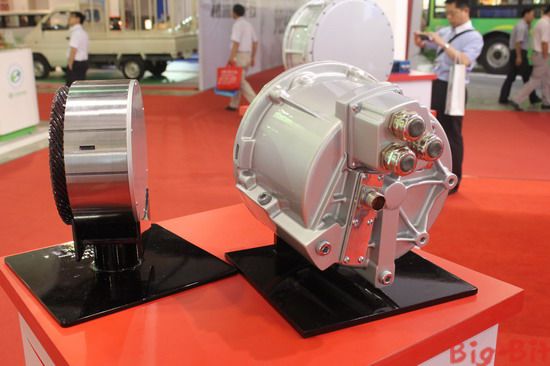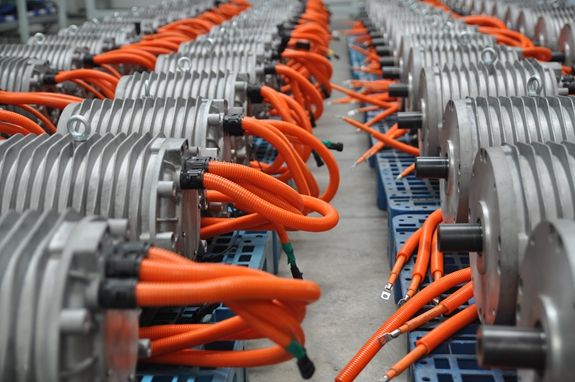News Center
Only by enduring trials and shouldering responsibilities can one have value.
Release Date:2017-10-21 Page View:48404
Electric Vehicle Resource Network News:
On October 18, Huayu Automobile issued an announcement that it planned to jointly invest with Magna International (Taicang) Automotive Technology Co., Ltd., a wholly-owned subsidiary of Magna International International, to establish Huayu Magna International Electric Drive System Co., Ltd. to deepen joint venture cooperation in electric drive system business.
Another joint venture company is about to enter the Chinese motor market. In contrast, in the first half of this year, the revenue and profit performance of the domestic motor industry was bleak. Data shows that in the first half of this year, Shanghai Electric Drive achieved a revenue of 208.6777 million yuan and a net profit of -8.4472 million yuan; The operating revenue of Zhenghai Magnetic New Energy Vehicle Motor Drive System was 117 million yuan, a year-on-year decrease of 60.03%; Wolong Electric's net profit decreased by 9.33%.

At present, the development situation of new energy vehicles is improving, and their related industries should also take advantage of this trend. However, the actual situation of new energy vehicle motor and electronic control production companies is not optimistic. In the first half of this year, the new energy vehicle motor sector experienced a downward trend in revenue and net profit. In addition, even if profits did not decline, the growth rate of some motor companies did not meet previous expectations.
It can be said that new energy motors have fallen into a dilemma of "internal and external troubles". Does the expected decline in the high-speed growth of new energy motors in the industry also mean that the motor industry will usher in a new round of transformation?
Multiple factors leading to industry decline
The operating conditions of motor companies in the first half of this year have been greatly affected by national policy adjustments, "Cai Wei, founder and CTO of Jingjin Electric Technology Co., Ltd., told reporters. At the end of 2016, the government adjusted the subsidy policies for the new energy vehicle industry and released a new version of the" New Energy Vehicle Promotion Subsidy Plan and Product Technical Requirements ", New energy vehicles need to reapply for entry into the Catalogue of Recommended Models for Promotion and Application of New Energy Vehicles according to new technology requirements in 2017. Therefore, in the first quarter of this year, especially when commercial vehicles were basically in a zero state, the supporting facilities for electric motor enterprises also significantly decreased. Entering the second quarter, there were relatively few models available for production, which affected production throughout the first half of the year.
In addition, another important reason is the rising cost of motor raw materials. Cai Wei pointed out that in the first half of this year, the prices of motor raw materials increased significantly, with an increase of 10% -50%. For example, the price of permanent magnets has increased by 50%.
Wang Xiaoquan, director of Soueast New Energy Technology Office, expressed a similar view. In his opinion, the reason why the motor industry generally did not meet expectations in the first half of this year is due to the increase in the cost of raw materials for motors, such as silicon steel and copper, which have increased by 20% -30%. The use of these materials by motors is very large, so it has a significant impact on the price of the entire machine. In addition, the main engine factory will have a certain price reduction ratio for component suppliers, resulting in a decline in the performance of motor companies in the first half of the year. In addition, the production of new energy vehicles in the first half of this year did not meet expectations, and the average cost did not decrease.
Shanghai Electric Drive also stated that the performance from January to June 2017 was lower than expected, with the main impact being the impact of changes in relevant industrial policies since 2016 on the overall production and sales of new energy vehicles.
From January to June this year, the production and sales of new energy vehicles in China were 212000 and 195000, with year-on-year growth of 19.70% and 14.40%, respectively. The growth rate has significantly slowed down and did not meet market expectations. From the vehicle data, the failure of the development of the new energy vehicle industry to meet the market expectations has indeed had a greater impact on the production and sales of the upstream new energy vehicle Powertrain system.
Jiang Tao, the chief engineer of Shanghai Futian Electric Technology Co., Ltd., believes that although the production of new energy vehicles has increased, the pressure of price reduction from vehicle manufacturers on motor companies is also significant. Therefore, it is normal for motor companies to experience a profit decline when costs rise.
What is the high or low threshold for the main engine factory to start working alone?
At present, there are more than 200 domestic electric motor enterprises, with varying production scales and technical capabilities. Like BYD, more and more host manufacturers are also starting to produce their own motors. In addition, some main engine manufacturers have also started collaborating with motor companies to establish joint ventures.

There is a disagreement between the main engine manufacturer and the motor manufacturer regarding the production of new energy motors. Motor companies have stated that the threshold for new energy vehicle motors is high, and many core technologies are still in the hands of foreign investors. Moreover, to produce high-performance products, it is necessary to have professional suppliers. The main engine factory stated that the technical threshold for motors is not high, and we have the full strength to produce motors ourselves.
So, as one of the three major electric vehicles, what is the technical threshold for electric motors?
A senior engineer of a new energy motor, Wang Xuefeng (pseudonym), told reporters that the technology of new energy motors is no less than that of engines, and the technology of some main engine manufacturers in the industry is no less than that of some motor companies. Based on factors such as having to master the core technology, low prices, timely supply, and easy communication, some host manufacturers tend to produce motors themselves. However, the requirement for motors is stable product quality and low prices. The cost-effectiveness of the motor produced by the host factory itself may not necessarily be higher than that of the supplier. Therefore, whether the main engine factory produces its own motor should be measured based on its actual situation.
Only by using materials and components with high cost-effectiveness can we produce products with high cost-effectiveness. Motor technology is not a matter of knowing or not, but rather a matter of knowing more and knowing less and whether it is good or not. "Cai Wei said that from the perspective of foreign development trends, a production model with finer division of labor and higher level of specialization is more profitable. The main engine factory inevitably encounters problems in both cost and quality control during its own production.
Where is the future path?
In 2016, there were over 100 domestic motor companies; In 2017, the total number of motor companies nearly doubled. With the encouragement of new energy policies, domestic motor production enterprises have sprung up like mushrooms after a rain. In addition, foreign companies such as Toyota have also begun to seek joint ventures to produce new energy vehicle motors and establish factories in China. It can be foreseen that the competition in the domestic motor industry will become more intense. Under the dual pressure of internal and external factors, how should the future development of electric motor enterprises take?

Regarding this, Jiang Tao believes that from the perspective of foreign development trends, it is a trend for vehicle manufacturers to produce motors themselves or jointly produce them. China will also develop towards this trend. In the future, motors will develop towards mass production and stable quality, and require leading production and product technologies. Faced with the pressure of foreign investment, domestic motor companies have a cost advantage, so there are still opportunities and great development space.
Cai Wei stated that as competition intensifies, enterprises without strength will be gradually eliminated. Therefore, motor companies need to innovate and develop, producing products with better performance and more advanced technology. In addition, the phenomenon of joint venture production will also increase.
Although the overall development of the motor market in the first half of the year was not satisfactory, in the wave of global automotive electrification development, motor companies are still optimistic about their future development. Some motor companies believe that as the haze of fraudulent verification in the first half of the year gradually dissipates and policies tend to stabilize, the prosperity of new energy vehicles is expected to recover in the second half of the year, and new energy motors will also continue to develop.
In Wang Xiaoquan's opinion, motor enterprises can seize the opportunity by joint venture production, or innovate in Technology roadmap, and gain market recognition by technological leadership.
Oceanic Electric also stated that it will make strategic adjustments from three aspects. One is to actively expand the company's existing main business market, improve the efficiency of using raised funds, actively expand product sales channels, increase market development efforts, adjust business ideas, actively develop technology development, after-sales service and other related businesses, and further expand the profit growth points of technology services and other businesses; The second is to improve the daily operational efficiency of the company and reduce operating costs; The third is to improve corporate governance, strengthen business management and internal control, and enhance the company's business management capabilities.